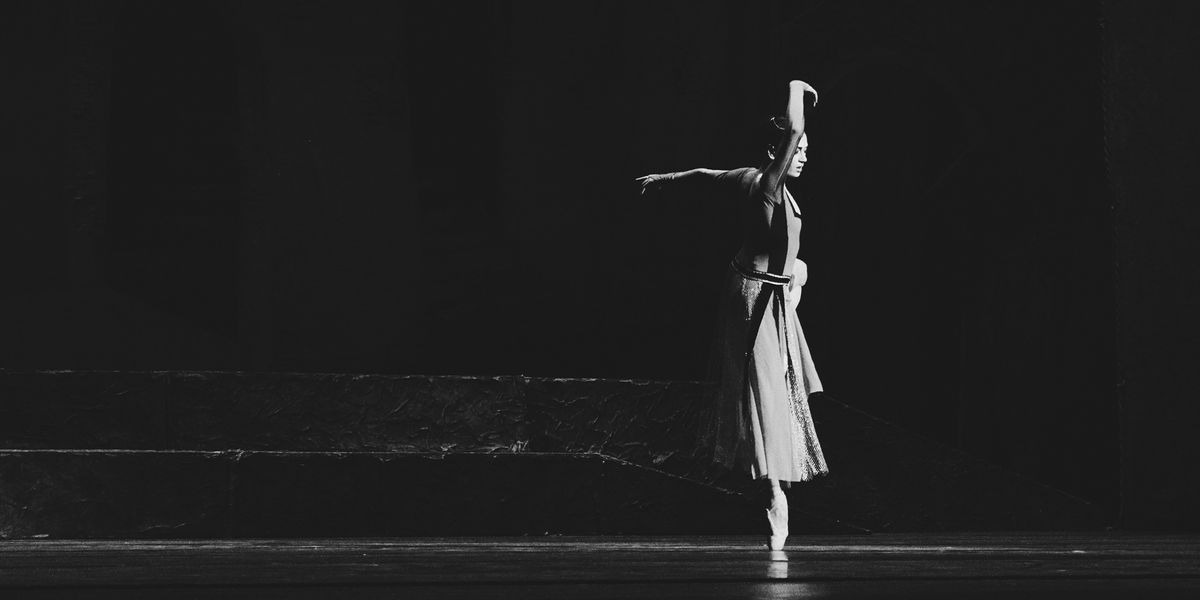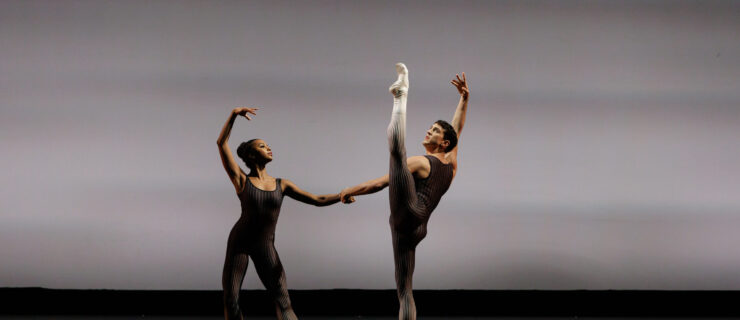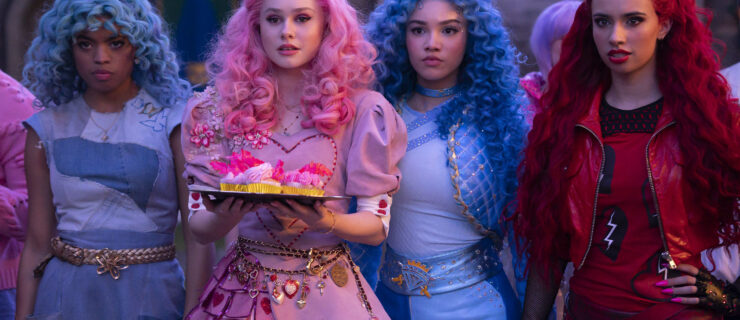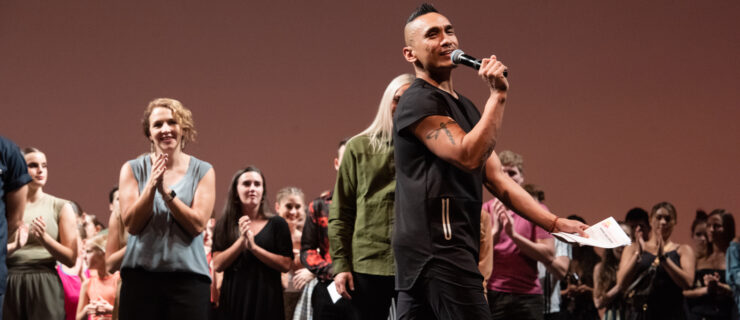The Power of Dance to Help Us Cope With Trauma
I’ve had a complicated relationship with dance over the years—from a young girl hell-bent on pursuing a career, to a professional injured on the brink of success, to a grown woman who shunned the art form for years to avoid dealing with physical and emotional pain.
But in the midst of the pandemic, hit with personal loss and grappling with my own battle with illness, I was compelled to face my dance demons head-on. And what I discovered was that dance had been with me all along. And as I turned to others in pain, I realized I wasn’t alone in experiencing this dance catharsis.
So, I went on a journey to discover what it is about dance that helps people cope with trauma and loss. Is it the community, the special bonds developed from years of rehearsals and auditions and performances? Is there something to be said for the pure athletic exertion of dance and the endorphins brought forth by exercise? Or does dance transcend other activities and provide us with a deeper connection to our own humanity?
Through a series of personal experiences, interviews and research, I found answers that brought peace and comfort—emotions difficult to come by today—which compelled me to share so that others may benefit. This is my story.
From national tragedy to national championship
It was a clear blue September morning—not unlike any other early fall day in New York City. I had planned on sleeping in, schlepping to my 11 am class at New York University, picking up some materials at the library, then frittering away the afternoon until dance team practice.
Unfortunately, that’s not quite how it worked out.
Instead, I froze in place, glued to a horrific nightmare happening outside my window. So many souls, many of them my dance sisters, were working in or near the twin monoliths I now witnessed churning out black smoke, hot fire and debris. Family, co-workers, friends, classmates—who knows how many more caught unaware as the buildings came tumbling down.
“I think the biggest thing for me was being with all of you,” says Caryn Roach, a former NYU dance team member who’s now an occupational therapist in Los Angeles, about recovering from the trauma of September 11. “We were a family. I felt safest with you.”

The NYU dance team in Daytona Beach, 2002
Courtesy Zamora
Deeply wounded but as yet unaware of the day’s long-term impact on our psyche, we dove back into rehearsals before classes resumed on campus. Some of the team, having been displaced from their dorms and unable to reach any of their possessions, spent their limited budgets on new dance gear. We trained our eye on bringing home a national championship trophy—for our city. And seven months later, in Daytona Beach, Florida, that’s exactly what we did.
Fast-forward to today and I always wonder how I would have made it through without those rehearsals, without those girls, without that singular focus on nailing that one routine on that one stage on that one day. But was it the camaraderie that ultimately got us through, or was it the dancing itself?
“I think with rehearsal, having some sense of normalcy and routine helped, but I don’t know if the actual dancing part did, aside from being a distraction,” says Roach. “You’re not thinking about the end of the world when you’re trying to learn a combination.”
Nearly 20 years later, I would put this theory to the test.
Mourning a dance legend brings dance family together
Now living in the San Francisco Bay Area, my county was one of the first to issue shelter-in-place orders at the start of the pandemic in early March. But I had already been hunkered down. As an unfortunate result of exposure to dust and toxins from 9/11, I had been diagnosed with stage IV lung cancer two years earlier and was at high risk for COVID-19.
By the time my dance mentor and surrogate grandmother Charlotte Klein passed away in May, I had been isolated for months…and hurting.
Klein was a nationally renowned studio director in Worcester, Massachusetts, for more than 60 years, training thousands of students in a rigorous pre-professional program, aligning with the Dance Masters of America organization and forging connections with master teachers and choreographers, such as Gus Giordano and Joe Lanteri. She earned a reputation for being as tough as nails (hers were always perfectly manicured), expecting excellence but offering unrelenting support in exchange.
There was not a dancer who walked through the doors of the Charlotte Klein Dance Centers that didn’t make it their life’s goal to impress Charlotte Klein. To a teenager, she seemed larger than life, her mystique so powerful that the minute she stepped into a class in progress, that class became an audition for her attention. She clearly had skill for sniffing out talent and elevating it. To be recognized by CK (as her students affectionately called her) was a real honor—you had to earn it.
For all her star status, though, CK’s most meaningful contribution might have been her ability to forge personal connections with her dancers, leaving her stamp and shaping not only our future dance careers but our identities. Klein had ascended beyond the role of studio director for hundreds of young, impressionable girls and boys.
After Klein died, former students Rachel Rubin, who took over the studio upon Charlotte’s retirement, and Sam Quinn, a 28-year-old professional dancer in New York City, formed a private Facebook group. The group was originally created to gather photos and stories from other former students to make a tribute video to Klein. However, it morphed into something more—a support group, a community, a place to find joy and escape the pandemic as the memories flooded in by the hundreds.
“The outpouring of emotion upon the news of my mother’s passing…to say it was enormous is a major understatement,” says Laura Klein-Weiner. “The posts on social media platforms had common themes: second mother, friend, mentor. People wondered how she had so much time for them when she had spent so much time with everyone.”
To see how far Klein’s influence spread and to share memories of traveling to competitions, hanging out in her living room, or remembering her in her chair at the front of the studio telling students to run the number “one more time!” (it was never just one more time) made us realize how profoundly she, and by extension dance itself, had changed our lives for the better.

From left to right: Laura Klein-Weiner, Sam Quinn and Charlotte Klein
Courtesy Zamora
“I was running my first solo for her in the studio, and she brought in three other senior company members and had them do their solos for me,” says Quinn. “She then asked, ‘What did you learn from them?’ She always had this way of teaching you how to better yourself.”
Charlotte and her husband Ben’s steadfast dedication to their students developed as a result of their own tragic experiences. They had lost two children to cystic fibrosis—one as a baby and the other as a 15-year-old girl. Instead of grinding their lives to a halt, the Kleins pressed onward and funneled their grief into forward motion through dance, the studio and each of its students, growing their family exponentially in the process.
“The Monday after they buried my sister, Elisa, my mother was back in the studio teaching her class,” says Klein-Weiner. “Both of my parents opted to live when my sister passed away. They chose to give the love that they had to all the children that walked through their doors.”
Because of the pandemic, Klein’s dance family wasn’t able to mourn her together physically. But a collective realization helped us all feel lighter and happier than we had in months: We could thank our dance matriarch and the principles of serious dance study for our ability to be resilient today. We could get through her passing and these unprecedented times because of dance’s impact on us as people, its ability to bring us together through crisis.
=
Moving through misery
Still, something nagged at me—a sense of restlessness that the conversations and fellowship and rewatching of old dance videos couldn’t quite quench. In reconnecting with other dancers, I felt it from them, too: We weren’t able to step back into the studio and dance through our sorrow. We couldn’t perform. We could hardly move.
“Growing up as a dancer, those four walls of the studio are our world. That’s all we know,” says Quinn. “Having that ripped out from under you takes a huge mental, physical, emotional toll.”
Having suffered a back injury at age 25 prior to going on my first professional dance tour, I remembered that feeling of instantaneous loss. Because my injury was severe enough (and because doctors couldn’t diagnose it for six years), I had to walk away from dance altogether. In doing so, I lost my sense of self. My whole identity was wrapped up in dance. How could I get over this devastating loss when I no longer had my coping mechanism? My dance friends were still present in my life, but the camaraderie was not enough.
After the injury, I worked as an editor for several dance magazines, even wrote a dozen children’s books on jazz, modern, hip hop and other dance forms. But I felt drained by the consistent, painful exposure to the industry I had so desperately wanted to join. Instead of embracing the community, I shunned it, divorcing myself so entirely from dance that I refused to even watch its popular TV programs or go see a live show.
Maybe if I had stepped into a studio, ruined form and all, I could have mended my soul in a healthier way. I began to ask my dance friends if it was more than just the bonds of friendship in our tight-knit community that helped us cope with trauma. Was there something in the movement itself?
“When I was 22, my boyfriend at the time died by suicide. We were living in Chicago, and I came home that weekend, and the only thing I knew to do was to go to the studio,” says Quinn. “After his passing, I created a solo for my sister called ‘Autumn Leaves,’ about missing someone and longing for them to come back. Having the ability to channel your feelings and emotions into a piece of art and movement is invaluable. Therapy is great, but I didn’t feel fulfilled just talking to my therapist.”
Klein-Weiner echoes Quinn’s sentiments, noting that she teaches her students to use their frustrations as an impetus to inject feeling into their movement, instead of settling for rote execution of the steps. In pushing that emotion through their bodies and into the music, they can purify and purge, getting a sense of catharsis. And while not every experience in the studio or onstage is stress-free—Klein-Weiner admits that the competitive and professional dance worlds can cause a great deal of anxiety—just a short period of movement creates a “lift.”
“Even as a 62-year-old woman, dancing with one bad foot and muscular pain, movement is the only thing that makes me feel like the best of who I am,” she says. “The focus. The zone that one has to be in, whether you’re learning, choreographing or just moving, it’s the zone in which all other things can fall away. It’s you and the music and the movement and the sweat and the endorphins.”
Of course, exercise gives you endorphins. Could I make this same argument, then, if I replaced dance with cross-training or aerobics? Is the simple act of breaking out in a sweat enough to sew up a mind split open by a traumatic event? You certainly don’t get the camaraderie of performing alongside your friends in a spin class. But perhaps replace dance with soccer or basketball, two team sports reliant on athletic skill and a group of people functioning as a unit, and you might get a little closer to the recipe for healthy grieving: Movement plus community equals healing. Perhaps.
I thought that might be end of my journey. Lessons learned. But then I met Johanna Climenko.
Dance therapy heals mind and body
Climenko is a pioneering board-certified dance movement therapist who has created her own modality that combines dance movement therapy with Reichian Character Analysis and Laban Movement Analysis.
Reichian Character Analysis is a psychoanalytic approach where character is dealt with both through psychological and body attitudes. Healing is addressed simultaneously with verbal exploration and how our habitual ways of experiencing or suppressing emotion get carved in our musculature, our breathing and our movement expression.
In dance movement therapy, the vehicle of connection is movement flow. The therapist meets the client by reflecting back how they inhabit their body, how they move dynamically and in space, and how they interact with others. Through this interchange, clients are able to connect to themselves and feel what they feel in the moment. Ideally, they can unearth deeply ingrained patterns and fully experience them in their bodies.
“Dance movement therapy works with how one inhabits one’s body and movement repertoire as a reflection of how one thinks, feels and operates in the world,” says Climenko. “On the most basic level, we’re dealing with observable behavior in the body and movement—how we breathe and connect to our bodies and how our heads, hearts, centers, pelvises and limbs are integrated or not. How do we connect thinking, feeling, centering, supporting ourselves and grounding? What is the flow both through our beings and between ourselves and the earth and the cosmos?”
I found Climenko while researching alternative modes of therapy to grapple with the collective traumas of my past and present. Traditional counseling had long missed the mark, and I was hoping to find someone who could answer my question: Is there something specifically healing about dance?
I set up a virtual session, pushing my bedroom furniture to the side and awkwardly standing in front of a laptop precariously positioned on a stack of pillows on my bed. We spoke for about 30 minutes to give Climenko a sense of what I was dealing with and what I hoped to achieve with therapy. Then, it was time to move.
As we worked our way from a gentle, swaying warm-up to the development of giving a few air punches and kicks to things that had wronged me, Climenko offered light suggestions on how to align my head and spine and feet. At first, I felt strange in my body and hyperaware, but as the session progressed, I began to let go, allowing myself to smile and feel the tribal drumbeat of the Malian music course through my fingers and toes. Suddenly, something clicked into place. A connection to the music and to my body. Energy flowing through my screen to Climenko and back again. Then tears. Release.
I didn’t understand exactly what was happening, but I knew it could not be achieved from exercise alone. The last time I cried on a treadmill was because I tripped over my own foot and fell hard. Those were not the tears of self-reflection and healing. These were. Why?
Climenko explained that dance is entirely different from a good workout. It’s a multidimensional, complex and highly orchestrated mode of expression that can be central to understanding ourselves and connecting to our community. It’s central to the fabric of what makes us human.
“People often use conventional exercise, like going to the gym, as a way to objectify their bodies, not feel themselves in their bodies,” she says. “Dance has been used historically and cross-culturally as integral to celebrating rites of passage, grieving losses, or imploring for divine assistance in battle or bringing an abundant harvest. It’s used to maintain and cleanse the body and soul of the individual and the collective.”
However, Climenko notes that dance has been squeezed out of much of Western culture and marginalized, its capabilities for healing, communication and connection diminished. Yet in other cultures, dance continues to be an essential form of communication. For example, when Nelson Mandela was released from prison in South Africa, he danced to the crowd gathered to welcome him—and the crowd danced back to him. It’s hard to imagine a similar scenario unfolding in the U.S. today. But perhaps that’s exactly what we’re missing.
At the end of my dance therapy session, Climenko explained that I had been holding and moving my head separately from the rest of me. When she instructed me to tweak my alignment, it allowed me to relink my mind to my body—and experience a transcendent connection. In fact, each time I noticed my head pulling away from my body in the days after my session, the adjustment sent lightning down my spine. I realized I had been so disappointed by my body over the years that I literally separated my brain, the only part I felt I could still count on, from the rest of me.
To Climenko, the true self is reflected in both the mind and body—they can’t be separated. And she empathized with what was going on with me right away.
“In observing nonverbal process, whether in dance therapy or everyday movement, there is nothing hypothetical. We are working with entirely observable behavior,” she says. “The nonverbal level—how one inhabits one’s body, movement repertoire and expression in the moment—reveals who we are and how we are feeling.”
Dance is the answer
After years of searching for peace, the answer was in front of me all along. Dance is magical, primitive, communal and (outside of those pushing their bodies to the extreme) a healthy and integral way to exist in harmony with yourself and others.
Dance changes people for the better. It gives us family when we might not have one. It gifts us with the strength to prevail over setbacks, whether it’s everyday anxieties or a tragic act of terrorism. It allows some cultures to settle their differences peacefully. It instills resilience and fortitude in its most passionate believers—whether to withstand harsh criticism or battle an ominous disease.
Dance combines community, athleticism and spirituality for optimal healing potential. The body experiences lift through the athleticism of dance movement while the mind benefits from learning intricate combinations and applying them rhythmically to the music. Going a level deeper, dance operates on a cultural and spiritual level as its practitioners must emotionally connect with themselves, the music, their dance partners and their audiences.
We might push our bodies to the limit and beyond. We might suffer in sickness, injury and isolation, anxious about the state of the world today and tomorrow. But if we let ourselves dance together (or, for now, virtually together), we can also heal together—even in our cramped living rooms.




